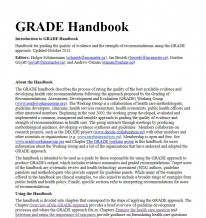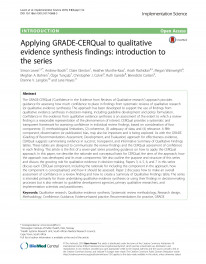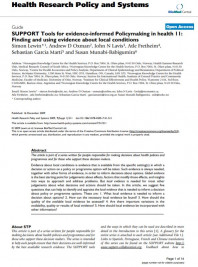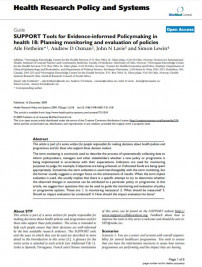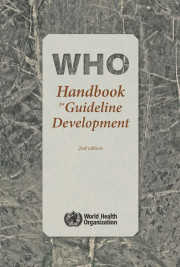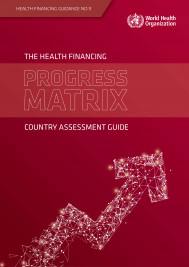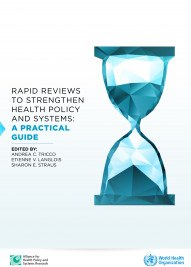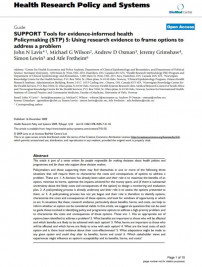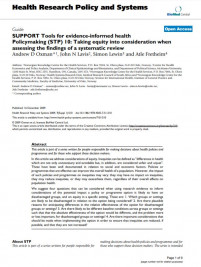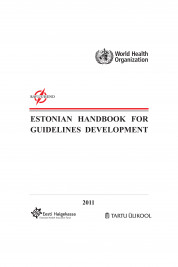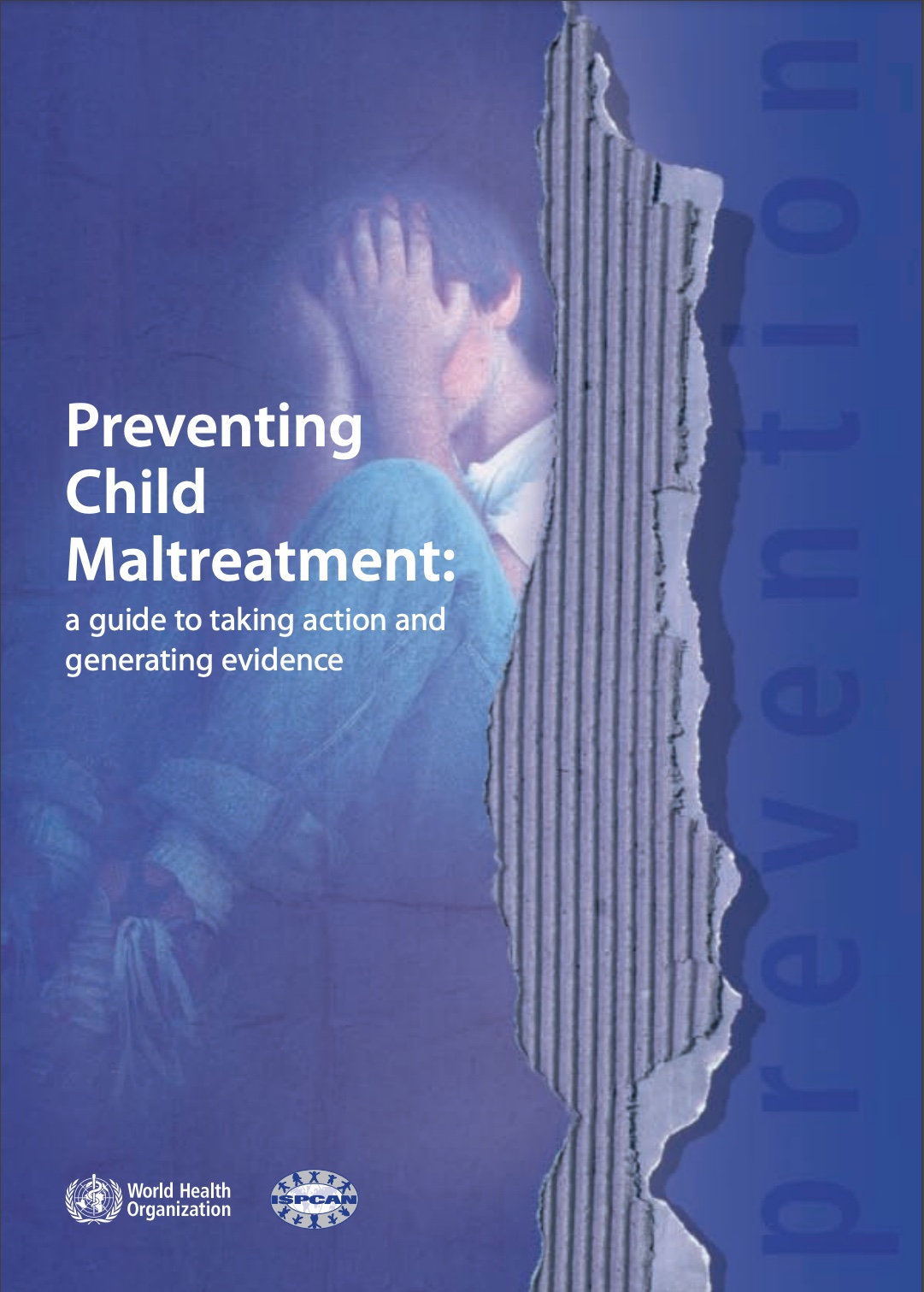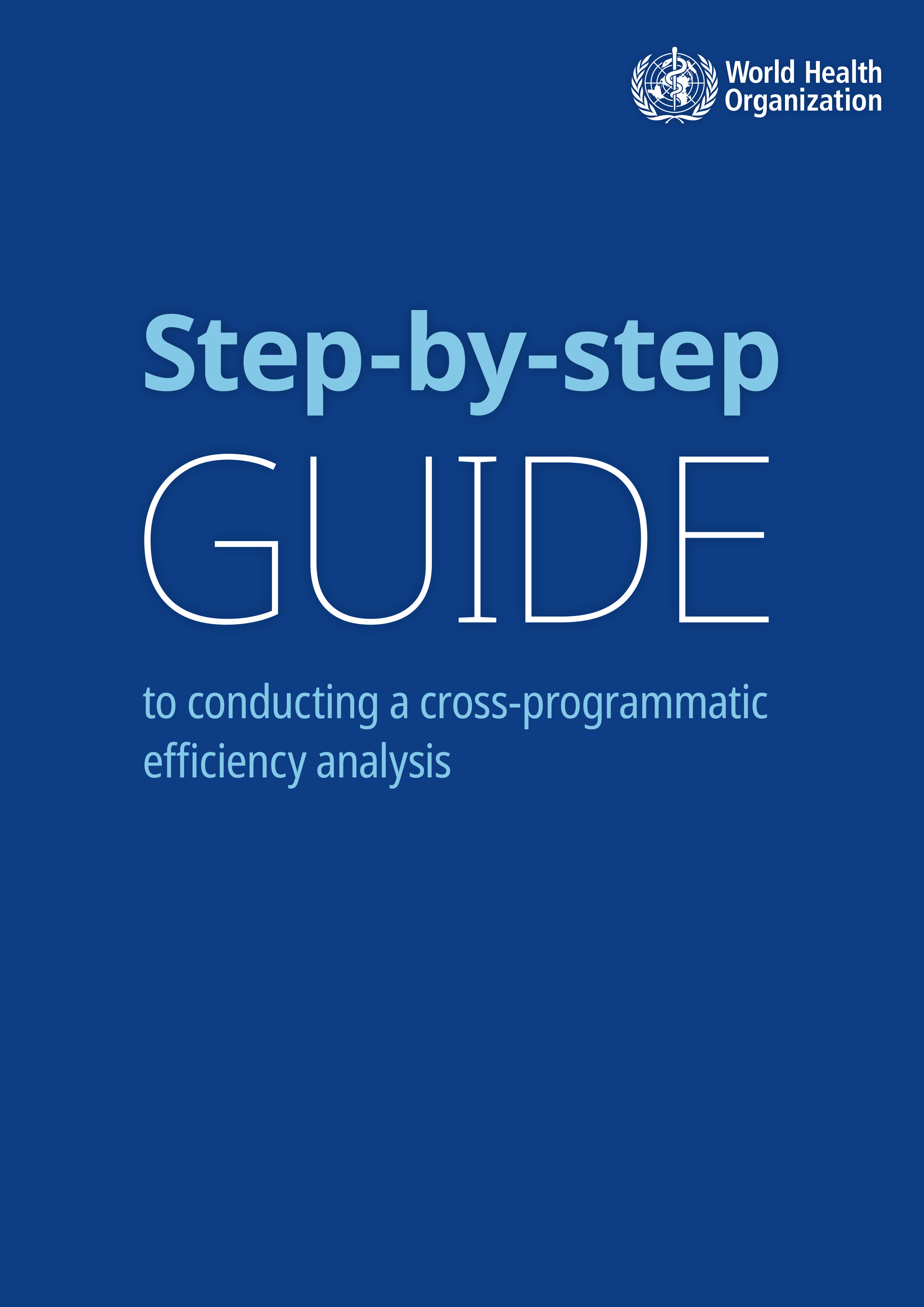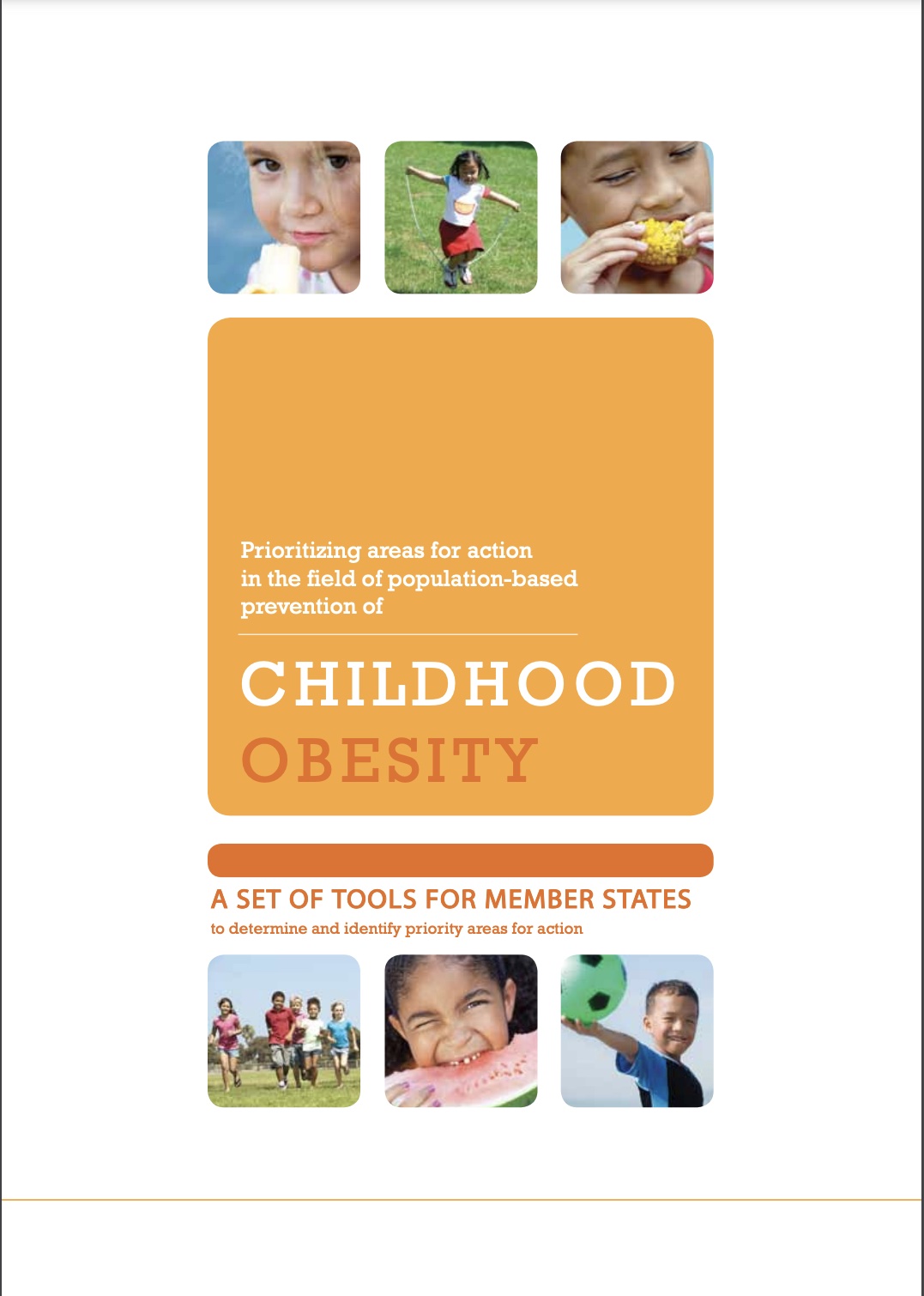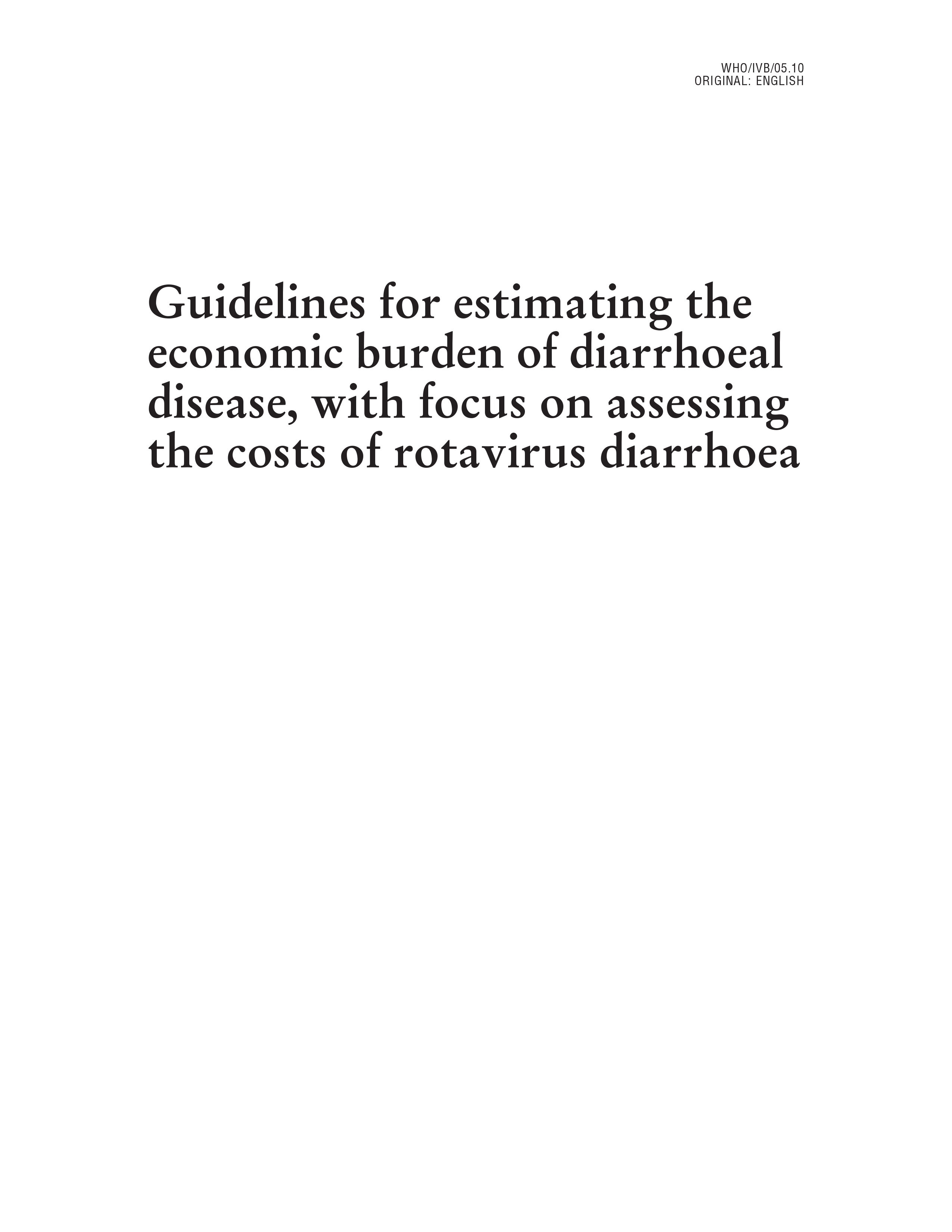Search
Development of AMSTAR: a measurement tool to assess the methodological quality of systematic reviews
Our objective was to develop an instrument to assess the methodological quality of systematic reviews, building upon previous tools, empirical evidence and expert consensus.A 37-item assessment tool w...
Evidence briefs for policy. Using the integrated knowledge translation approach. Guiding manual
Evidence Briefs for Policy (EBPs) are a relatively new, innovative approach to packaging research evidence for policy-makers; however, they are already the most widely used tool. EBPs are prepared by...
SURE Guides for Preparing and Using Evidence-Based Policy Briefs 3. Clarifying the problem
SURE Guide 3 is part of the SURE Guides for Preparing and Using Evidence-Based Policy Briefs. The SURE Guides are intended for those people responsible for preparing and supporting the use of policy b...
SURE Guides for Preparing and Using Evidence-Based Policy Briefs 2. Prioritising topics for policy briefs
SURE Guide 2 is part of the SURE Guides for Preparing and Using Evidence-Based Policy Briefs. The SURE Guides are intended for those people responsible for preparing and supporting the use of policy b...
GRADE Handbook
The GRADE handbook describes the process of rating the quality of the best available evidence and developing health care recommendations following the approach proposed by the Grading of Recommendatio...
Evidence synthesis for health policy and systems: a methods guide
This methods Guide explores various ways to address the challenges of synthesizing evidence from HPSR including methods and tools to conduct and promote the uptake of evidence synthesis for health pol...
Communication and Advocacy Checklist: EVIPNet Europe
The aim of this document is to serve EVIPNet Europe country teams and WHO country offices as a summary of the major communication considerations associated with communicating about and advocating for...
Policy Dialogue Preparation and Facilitation Checklist - EVIPNet Europe
The aim of this document is to guide policy dialogue (PD) facilitators and their teams (including the WHO country office and the evidence brief for policy team) in leading a PD process that will effec...
Beginning with the end in mind: planning pilot projects and other programmatic research for successful scaling up
The Beginning with the end in mind tool offers recommendations for designing and implementing a pilot, demonstration or implementation research project with scaling up in mind. This document is based...
Nine steps for developing a scaling-up strategy
The Nine Steps for developing a scaling-up strategy tool and associated worksheets are based on the ExpandNet framework and provide stepwise guidance to develop a sc...
Practical guidance for scaling up health service innovations
The Practical Guidance tool identifies general scaling-up principles and provides examples from case studies of successful scale-up initiatives. It is helpful at the design stage, during implementatio...
Applying GRADE-CERQual to qualitative evidence synthesis findings: introduction to the series
The GRADE-CERQual (‘Confidence in the Evidence from Reviews of Qualitative research’) aims to assess the degree of confidence of the findings from systematic reviews of qualitative research (or qualit...
TDR Implementation Research Toolkit
This toolkit provides deeper learning on implementation research, helping people learn a standard process that can lead to results that can be compared across regions and countries. It is designed to...
Implementation Research in Health: A Practical Guide
Implementation issues arise as a result of a range of factors including ‘real world’ contextual factors that are either overlooked or not captured by other research disciplines. Implementation researc...
Strengthening national evidence-informed guideline programs. A tool for adapting and implementing guidelines in the Americas
The purpose of this document is to present policy-oriented and methodological strategies for developing and/or strengthening national guideline programs, focusing on the adaptation of evidence-informe...
SUPPORT Tools for evidence-informed Policymaking in health (STP) 11: Finding and using evidence about local conditions
This article is part of a series written for people responsible for making decisions about health policies and programmes and for those who support these decision makers.Evidence about local condition...
SUPPORT Tools for evidence-informed health Policymaking (STP) 14: Organising and using policy dialogues to support evidence-informed policymaking
This article is part of a series written for people responsible for making decisions about health policies and programmes and for those who support these decision makers.Policy dialogues allow researc...
SUPPORT Tools for evidence-informed health Policymaking (STP) 15: Engaging the public in evidence-informed policymaking
This article is part of a series written for people responsible for making decisions about health policies and programmes and for those who support these decision makers.In this article, we address st...
SUPPORT Tools for Evidence-informed Policymaking in health (STP) 18: Planning monitoring and evaluation of policies
This article is part of a series written for people responsible for making decisions about health policies and programmes and for those who support these decision makers.The term monitoring is commonl...
SUPPORT Tools for evidence-informed health Policymaking (STP) 3: Setting priorities for supporting evidence-informed policymaking
This article is part of a series written for people responsible for making decisions about health policies and programmes and for those who support these decision makers.Policymakers have limited reso...
SUPPORT Tools for evidence-informed health Policymaking (STP) 4: Using research evidence to clarify a problem
This article is part of a series written for people responsible for making decisions about health policies and programmes and for those who support these decision makers.Policymakers and those support...
SUPPORT Tools for Evidence-informed Policymaking in health (STP) 6: Using research evidence to address how an option will be implemented
This article is part of a series written for people responsible for making decisions about health policies and programmes and for those who support these decision makers.After a policy decision has be...
SUPPORT Tools for evidence-informed health Policymaking (STP) 7: Finding systematic reviews
This article is part of a series written for people responsible for making decisions about health policies and programmes and for those who support these decision makers.Systematic reviews are increas...
SUPPORT Tools for evidence-informed health Policymaking (STP) 9: Assessing the applicability of the findings of a systematic review
This article is part of a series written for people responsible for making decisions about health policies and programmes and for those who support these decision makers.This article suggests question...
SURE Guides for Preparing and Using Evidence-Based Policy Briefs 4. Deciding on and describing policy options
SURE Guide 4 is part of the SURE Guides for Preparing and Using Evidence-Based Policy Briefs. The SURE Guides are intended for those people responsible for preparing and supporting the use of policy b...
SURE Guides for Preparing and Using Evidence-Based Policy Briefs 5. Identifying and addressing barriers to implementing policy options
SURE Guide 5 is part of the SURE Guides for Preparing and Using Evidence-Based Policy Briefs. The SURE Guides are intended for those people responsible for preparing and supporting the use of policy b...
SURE Guides for Preparing and Using Evidence-Based Policy Briefs 6. Clarifying uncertainties and needs for monitoring and evaluation
SURE Guide 6 is part of the SURE Guides for Preparing and Using Evidence-Based Policy Briefs. The SURE Guides are intended for those people responsible for preparing and supporting the use of policy b...
SURE Guides for Preparing and Using Evidence-Based Policy Briefs 7. Organising and running policy dialogues
SURE Guide 7 is part of the SURE Guides for Preparing and Using Evidence-Based Policy Briefs. The SURE Guides are intended for those people responsible for preparing and supporting the use of policy b...
SURE Guides for Preparing and Using Evidence-Based Policy Briefs 8. Informing and engaging stakeholders
SURE Guide 8 is part of the SURE Guides for Preparing and Using Evidence-Based Policy Briefs. The SURE Guides are intended for those people responsible for preparing and supporting the use of policy b...
WHO Evaluation Practice Handbook
The purpose of this handbook is to complement WHO’s evaluation policy and to streamline evaluation processes by providing step-by-step practical guidance to evaluation in WHO. It aims to foster the cu...
WHO handbook for guideline development
A WHO guideline is any document developed by the World Health Organization containing recommendations for clinical practice or public health policy. A recommendation tells the intended end-user of the...
A resource for developing an evidence synthesis report for policy-making
HEN – the Health Evidence Network – is an information service for public health decision-makers in the WHO European Region, in action since 2003 and initiated and coordinated by the WHO Regional Offic...
A system-wide approach to analysing efficiency across health programmes
Health programmes are able to target health interventions for specific diseases or populations, and historically, countries have relied heavily on them to deliver priority services. In low- and middle...
AccessMod
AccessMod (version 5) is a free and open-source standalone software to model geographic accessibility to health services. The tool uses information on population location, health facility location, ge...
The Appraisal of Guidelines for Research & Evaluation Instrument II (AGREE II)
The Appraisal of Guidelines for REsearch & Evaluation (AGREE) Instrument was developed to address the issue of variability in guideline quality. To that end, the AGREE instrument is a tool that as...
Analytical guide to assess a mixed provider payment system
In nearly all countries, several payment methods co-exist and constitute a mixed provider payment system (MPPS). Providers are paid by several payment methods and are faced with several incentives tha...
CAPACITI decision-support tool
The Country-led Assessment for Prioritisation on Immunisation (CAPACITI) project aims to strengthen the ability of LMICs to evaluate immunisation options according to their priorities and programme co...
Conceptual Background and Case Studies – Introduction to EVIPNet Europe
EVIPNet is a knowledge translation network established by WHO. EVIPNet envisions a world in which policy-makers and other stakeholders in low- and middle-income countries use the best available resear...
Country cooperation strategy guide 2020: implementing the Thirteenth General Programme of Work for driving impact in every country
The Country Cooperation Strategy (CCS) is WHO’s strategic framework to guide the Organization’s work in and with a country. It responds to that country’s National Health and Development Agenda and ide...
COVID-19 Vaccine Introduction and deployment Costing tool (CVIC tool)
The CVIC tool supports credible COVID-19 vaccination costing to facilitate a dialogue with stakeholders, while maintaining sensitivity to protect essential health services.The CVIC tool provides a str...
Facilitator's guide: using research in the EVIPNet framework
This Guide provides complete instructions and materials needed to conduct a workshop in which participants are guided towards (i) acquiring, assessing, adapting and applying evidence that is relevan...
Governance for strategic purchasing: An analytical framework to guide a country assessment
This document sets out an analytical framework for assessing a country’s governance arrangements for the purchasing function. The purpose of such an assessment is to assist policy-makers and policy ad...
Guide to qualitative evidence synthesis: evidence-informed policy-making using research in the EVIPNET framework
This guide aims to support country efforts to generate evidence, including qualitative evidence. It summarizes what a qualitative evidence synthesis is, and how it can contribute to the evidence-infor...
Country assessment guide: the health financing progress matrix
The Health Financing Progress Matrix (HFPM) is a standardized approach to assessing a country’s health financing system. Primarily qualitative in nature, the HFPM considers health financing institutio...
Health Technology Assessment Toolbox for Emerging Settings: Best Practices and Recommendations
This toolbox is focused on the use of health technology assessment (HTA) in emerging settings. Its primary audience is&nbs...
Lessons from the Health Evidence Network (HEN): Lessons learned about delivering an evidence synthesis service for policy-makers
HEN is an information service for public health decision-makers in the WHO European Region, in action since 2003 and initiated and coordinated by the WHO Regional Office for Europe. HEN supports publi...
Making GRADE the Irresistible Choice authoring and publication platform (MAGICapp)
MAGIC (Making GRADE the Irresistible Choice) is a non-profit foundation with the goal of increasing value and reducing waste in healthcare through a digital and trustworthy evidence ecosystem. MAGICap...
OneHealth Tool
The OneHealth Tool is a software tool designed to inform national and subnational strategic health planning in low- and middle-income countries.While many costing tools take a narrow disease-specific...
Options for best practice clinical guideline development in Ukraine: policy brief
This policy brief summarizes the results of this study and describes best practice structures, processes and methods for guideline development in Ukraine. Key messages include the requirement for inve...
Rapid reviews to strengthen health policy and systems: a practical guide
Policy-makers require valid evidence to support time-sensitive decisions regarding the coverage, quality, efficiency, and equity of health systems. Systematic reviews and other types of evidence synth...
SCORE for Health Data Technical Package
The SCORE for Health Data Technical Package has been developed by WHO and partners to assist Member States in strengthening country data systems and capacities to monitor and track progress towards th...
EVIPNet Europe: Situation Analysis Manual
The World Health Organization (WHO)’s Evidence-informed Policy Network (EVIPNet) has supported Member States in designing, implementing and institutionalizing efforts to support evidence-informed poli...
Sound Choices: Enhancing capacity for evidence-informed health policy
This Guide addresses a mismatch between what is known about how to respond to particular health problems in poor economies and what is actually done about them. It focuses on one cause of the problems...
SUPPORT Tools for evidence-informed health Policymaking (STP) 1: What is evidence-informed policymaking?
This article is part of a series written for people responsible for making decisions about health policies and programmes and for those who support these decision makers.In this article, the following...
SUPPORT Tools for evidence-informed health Policymaking (STP) 2: Improving how your organisation supports the use of research evidence to inform policymaking
This article is part of a series written for people responsible for making decisions about health policies and programmes and for those who support these decision makers.In this article, ways of organ...
SUPPORT Tools for evidence-informed health Policymaking (STP) 5: Using research evidence to frame options to address a problem
This article is part of a series written for people responsible for making decisions about health policies and programmes and for those who support these decision makers.Policymakers and those support...
SUPPORT Tools for evidence-informed health Policymaking (STP) 8: Deciding how much confidence to place in a systematic review
This article is part of a series written for people responsible for making decisions about health policies and programmes and for those who support these decision makers.The reliability of systematic...
SUPPORT Tools for evidence-informed health Policymaking (STP) 10: Taking equity into consideration when assessing the findings of a systematic review
This article is part of a series written for people responsible for making decisions about health policies and programmes and for those who support these decision makers.This article addresses conside...
SUPPORT Tools for evidence-informed health Policymaking (STP) 13: Preparing and using policy briefs to support evidence-informed policymaking
This article is part of a series written for people responsible for making decisions about health policies and programmes and for those who support these decision makers.Policy briefs are a relatively...
SUPPORT Tools for evidence-informed health Policymaking (STP) 16: Using research evidence in balancing the pros and cons of policies
This article is part of a series written for people responsible for making decisions about health policies and programmes and for those who support these decision makers.In this article, the use of ev...
SUPPORT Tools for evidence-informed health Policymaking (STP) 17: Dealing with insufficient research evidence
This article is part of a series written for people responsible for making decisions about health policies and programmes and for those who support these decision makers.In this article, the issue of...
SURE Guides for Preparing and Using Evidence-Based Policy Briefs 1. Getting started
SURE Guide 1 is part of the SURE Guides for Preparing and Using Evidence-Based Policy Briefs. The SURE Guides are intended for those people responsible for preparing and supporting the use of policy b...
The WHO-INTEGRATE evidence to decision framework version 1.0: integrating WHO norms and values and a complexity perspective
Evidence-to-decision (EtD) frameworks intend to ensure that all criteria of relevance to a health decision are systematically considered. This paper, part of a series commissioned by the WHO, reports...
Tobacco product regulation: basic handbook
WHO has launched a handbook on tobacco product regulation in response to the need for clear, practical guidance on tobacco product regulation.Although tobacco product use is a major public health prob...
Selection of essential medicines at country level: Using the WHO model list of essential medicines to update a national essential medicines list
Since 1977, WHO has been working with countries to design the package of essential medicines as an integral component of treatment within the continuum of care, developing and disseminating the Model...
Evidence, policy, impact: WHO guide for evidence-informed decision-making
This document is meant to provide guidance to all staff of the World Health Organization (WHO), of Member States and in partner organizations who need to create, commission, fund, broker or apply evid...
A Guide for Evidence-Informed Decision-Making, Including in Health Emergencies
This guide aims to bring together the most recent thinking in the EIDM field and to present this in a format that is accessible to a wide audience of EIDM practitioners. It builds on, and contextuali...
SUPPORT Tools for evidence-informed health Policymaking (STP) 12: Finding and using research evidence about resource use and costs
This article is part of a series written for people responsible for making decisions about health policies and programmes and for those who support these decision makers.This article addresses conside...
Estonian Handbook for Guidelines Development
Clinical practice guidelines are generally accepted as an important tool for improving the quality of clinical care provided by health professionals, as well providing guidance to ensure the quality u...
AMSTAR 2: a critical appraisal tool for systematic reviews that include randomised or non-randomised studies of healthcare interventions, or both
The number of published systematic reviews of studies of healthcare interventions has increased rapidly and these are used extensively for clinical and policy decisions. Systematic reviews are subject...
Behavioural and social drivers of vaccination: tools and practical guidance for achieving high uptake
Understanding how people think, feel and act in relation to vaccination is vital to informing the development of strategies to generate acceptance and uptake for the vaccines. Generating and using dat...
Systems Thinking for Health Systems Strengthening
In the previous decades, little was understood about what works in health systems strengthening and how researchers and policymakers can apply it. So, although there was general agreement for the need...
WHO Cervical Cancer Prevention and Control Costing (C4P) Tool
The Department of Immunization, Vaccines and Biologicals (IVB) in WHO has developed a generic costing and planning tool for cervical cancer prevention and control. The WHO Cervical Cancer Prevention a...
Institutionalizing health technology assessment mechanisms: a how to guide
As countries face financing constraints in achieving their universal health coverage goals, they must ensure that available resources are spent more efficiently. The institutionalization of healt...
SPECTRUM Generalized Cost-Effectiveness Analysis
SPECTRUM Generalized Cost-Effectiveness Analysis (GCEA) is a tool developed to facilitate country-level cost-effectiveness analysis of a wide range of health interventions. The tool is populated with...
Policy in action: a tool for measuring alcohol policy implementation
Europe has the highest alcohol consumption and alcohol-attributable disease burden in the world. In 2011, all 53 Member States of the WHO European Region endorsed the European action plan to reduce th...
Preventing child maltreatment: a guide to taking action and generating evidence
The main aim of this guide is to provide technical advice for setting up policies and programmes for child maltreatment prevention and victim services that take into full account existing evidence on...
Tools for making good data visualizations: the art of charting
Data visualization is a collection of methods that use visual representations to explore, make sense of and communicate quantitative data. It allows trends and patterns in quantitative data to be seen...
Systems thinking for noncommunicable disease prevention policy: guidance to bring systems approaches into practice
Systems thinking is a comparatively novel but rapidly developing area of knowledge that can offer a number of approaches to address complex public health problems such as the prevention of noncommunic...
Climate change and health: a tool to estimate health and adaptation costs
Adaptation is one of the approaches to prevent or reduce some of the effects caused by climate change, including health effects. To support ministries planning for climate change adaptation measures,...
How to implement influenza vaccination of pregnant women: An introduction manual for national immunization programme managers and policy makers
This manual serves as a primary resource and a catalogue of optional tools to help users to decide, plan and implement maternal influenza vaccination strategies and to foresee and address potential ch...
A guide to implementation research in the prevention and control of noncommunicable diseases
The main purpose of this guide is to provide practical guidance, tools and examples for implementation research so as to support effective implementation of NCD policy options and cost-effective inter...
Analysing and using routine data to monitor the effects of COVID-19 on essential health services: practical guide for national and subnational decision-makers: interim guidance, 14 January 2021
The objective of this guide is to help countries monitor and analyse the impact of COVID-19 on essential health services to ultimately inform planning and decision-making. It provides practical recomm...
Costing tool for estimating the cost of interventions to improve hand hygiene in domestic settings
A critical building block to achieving the global goal of universal hand hygiene by 2030 is adequate levels of funding. Understanding the costs of implementing hand hygiene plans is an essential precu...
Step-by-step guide to conducting a cross-programmatic efficiency analysis
The World Health Organization (WHO) has developed a diagnostic approach to enable countries to look across health programmes that are part of their health system to detect “cross-programmatic” ineffic...
Guidance on an adapted evidence to recommendation process for National Immunization Technical Advisory Groups
This guidance describes a systematic approach called the “Evidence to Recommendation Process” (henceforth called “EtRProcess”) for use by national immunization technical advisory groups (NITAGs)....
E4As guide for advancing health and sustainable development: resources and tools for policy development and implementation
Achieving the Sustainable Development Goals (SDGs) requires working in transformative ways. This guide is a compilation of tools and resources for advancing health and sustainable development in cou...
National Immunization Strategy costing application (NIS.COST)
During the past two decades, the comprehensive multi-year planning (cMYP) process has been the cornerstone of strategic planning for immunization as part of the Global Vaccine Action Plan (2011-2020)....
Support tool to strengthen health information systems: guidance for health information system assessment and strategy development
This tool is an update of the 2015 Support tool to assess health information systems and develop and strengthen health information strategies. Both the global General Programme of Work and the Europea...
Helmets: a road safety manual for decision-makers and practitioners, 2nd edition
Safe, quality helmets reduce the risk of death in a road crash by over six times, and reduce the risk of brain injury by up to 74%. Head trauma is the leading cause of death for riders, and motorcycle...
Climate change mitigation, air quality and health (CLIMAQ-H) tool
The Climate change mitigation, air quality and health (CLIMAQ-H) calculation tool allows quantification of the physical and economic consequences for human health achieved through improvements in coun...
A strategic approach to strengthening control of reproductive tract and sexually transmitted infections: use of the programme guidance tool
The Programme Guidance Tool (PGT) facilitates an action-oriented process that can be used by decision-makers to set goals and directions and to prioritize interventions for addressing the problem of r...
The project has ended but we can still learn from it! Practical guidance for conducting post-project evaluations of adolescent sexual and reproductive health projects
Many adolescent sexual and reproductive health (ASRH) projects encounter and address policy and programmatic challenges, and in doing so, learn valuable lessons. Since careful documentation and rigoro...
Prioritizing areas for action in the field of population-based prevention of childhood obesity: a set of tools for Member States to determine and identify priority areas for action
The purpose of this document is to provide a set of tools for Member States to determine and identify priority areas for action in the field of population-based prevention of childhood obesity. The to...
Assessing financing, education, management and policy context for strategic planning of human resources for health
This document contains a method for assessing the financial, educational and management systems and policy context, essential for strategic planning and policy development for human resources for heal...
Developing national action plans on transport, health and environment: a step-by-step manual for policy-makers and planners
A national transport, health and environment action plan (NTHEAP) is a key tool and mechanism for developing sustainable and healthy transport in a country. NTHEAPs provide a comprehensive and inter...
Implementing citizen engagement within evidence-informed policy-making: an overview of purpose and methods
This overview provides a fundamental understanding of citizen engagement (CE) and its relevance to the evidence-informed policy (EIP) work of the World Health Organization (WHO) and its Member States....
Supporting the routine use of evidence during the policy-making process: a WHO checklist
This WHO checklist is for any organization or person supporting the routine use of evidence in the process of policy-making. This checklist was developed by the WHO Secretariat of Evidence-Infor...
Guidelines for estimating the economic burden of diarrhoeal disease, with focus on assessing the costs of rotavirus diarrhoea
The objective of these guidelines is to present a method for determining the costs associated with diarrhoeal disease in children under five years of age. Methods for estimating the costs from the vie...






